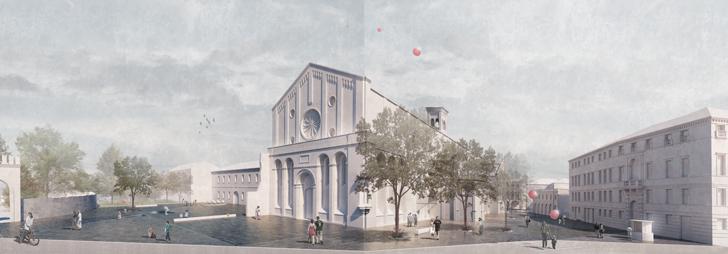 Church of the Eremitani.
Church of the Eremitani.
The Eremitani Church nearby, erected at the turn of the 14th and 15th centuries, was almost completely demolished during an Allied bombing raid in 1944 r., and then meticulously rebuilt (usually open Mon-Sat. 8.15-12.00 i 15.30-18.30, nd. 9.00-12.00 i 15.30-18.00). The photos to the left of the apse show the extent of the damage, which included frescoes depicting the lives of St.. James and St.. Krzysztof by Mantegna - the hardest blow, what the war inflicted on Italy's artistic schema.
In his twenties, Mantegna painted frescoes in 1454-1457, masterfully using a geometric perspective from a specific point - the key idea of Renaissance humanism, which distinguished the primacy of individual perception. How great was this achievement, Today we can only judge from the blurred photos and fragments preserved in the chapel to the right of the main altar. On the left wall is Martyrdom i. James, composed of debris found among the rubble, and on the right the Martyrdom of St.. Christopher, which was removed from the wall before the war.
Square of the Holy i Bazylika
Not counting the stalls, on which you can buy decorative candles and giant rosaries, the main attraction in Piazza del Santo is the statue of Gattamelata carved by Donatello, as the condottiere Erasmo da Narni was called. He died in 1443 r., and the monument, being the first large bronze sculpture in the Renaissance period, was built ten years later. The sculpture is a direct model for the Venetian statue of Colleoni by Verrocchio, although it is difficult to find two more different works: Gattamelata was famous for his honesty and dignity, therefore Donatello gave the statue an expression of sensitivity and restraint, while Verrocchio conveyed the image of a person gaining power by force. The conformation of the horse is a double allusion: to the Roman statue of Marcus Aurelius on horseback in Rome and to the horses in St.. Mark's in Venice.
St. Antoni was canonized eighteen months after his death and his tomb soon attracted so many pilgrims, that it was decided to build the Basilica di San Antonio, that is, II Santo (in summer 6.30-19.45; winter 6.30-19.00). However, it was not until the 14th century. the church was in a condition that allowed the body to be placed in the Cappella del Santo (in the left transept). The grave is full of votive gifts, such as photographs of the limbs of people healed thanks to the saint's intervention. There are nine plaques in the chapel showing scenes from the life of St.. Anthony; were made in the years 1505-1577 and constitute the most important series of relief sculpture in 16th-century Italy.
With the chapel of St.. Antoniego sąsiaduje Chapel of the Moor Madonna (named after a 14th-century French altar sculpture), which in turn leads to the Cappella Beato Luca covered with 14th-century frescoes, including the captivating image of St.. James, lifting up the prison tower, to free the condemned man. In the aisle, right near Cappella del Santo, there is Pietra Lombardo's best work in Padua, statue of Antonio Roselli (1467). Even more impressive are the bronze sculptures and reliefs of Donatello on the main altar (1444-45), which, as it were, introduced Renaissance Classicism in Padua. W Chapel of the Treasury (8.00-12.00 i 14.30-19.00), the farthest place of the presbytery, the tongue and jaw of St.. Anthony.
South side of the Piazza.
To the left of the basilica are Oratorio di San Giorgio and Scuola di Santo (codz. IV-IX 8.30-12.30 i 14.30-18.30; II, III, X i XI 9.00-12.30 i 14.30-16.30; XII-I 9.00-12.30; 1000 L). Oratorio was built in 1377 r. as a tomb chapel, and shortly thereafter, Altichiero di Zevio and Jacopo Avanzi covered it with frescoes. One wall is decorated with a fresco with the unusual title of St.. Lucia remains unmoved after trying to drag her wills into the tabernacle of debauchery.
Scuola was founded shortly after the canonization of St.. Anthony, although the present building dates from the beginning of the 15th century. The ground floor is still used for religious purposes, while the upper storey is preserved in a condition similar to that of the 16th century, with beautiful plafonds and paintings, mainly from the period 1509-1515. Four paintings are attributed to Titian.
The Pinacoteea Civica is adjacent to Scuola (wt.-sb. 9.00-13.00, nd. 9.30-13.00; 2000 L, w nd. Free entrance), a collection of works of art from the 16th to 18th centuries, originating in the Veneto area. The most interesting ones are the crucifix painted by Giotto for the Scrovegni and the Portrait of a Young Senator by Bellini.
You can take a break from all this art by going around the corner to Orto Botanico, the oldest botanical garden in Europe (5th-half. IX pn.-pt. 9.00-13.00 i 15.00-18.00, sb. i nd. 9.00-13.00; III, IV and mid. IX-X pn.-sb. 9.00-13.00, nd. 9.30-13.00; XI-II mon.-sat. 9.00-13.00; 3000 L). The gardens were founded in 1545 r. by the medical faculty of the university as a collection of medicinal herbs and are preserved in a similar arrangement to the original, The plant specimens have not changed much either. W 1786 r. Goethe came here, to view the palm tree planted in 1585 r., which still stands today.